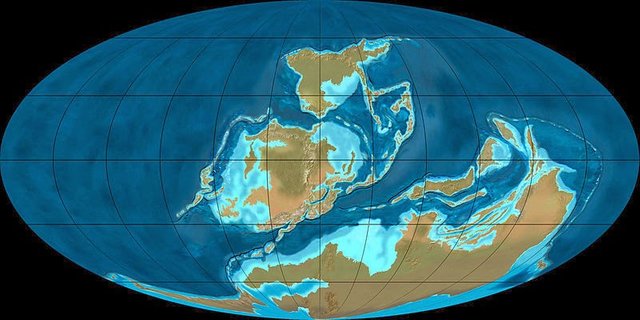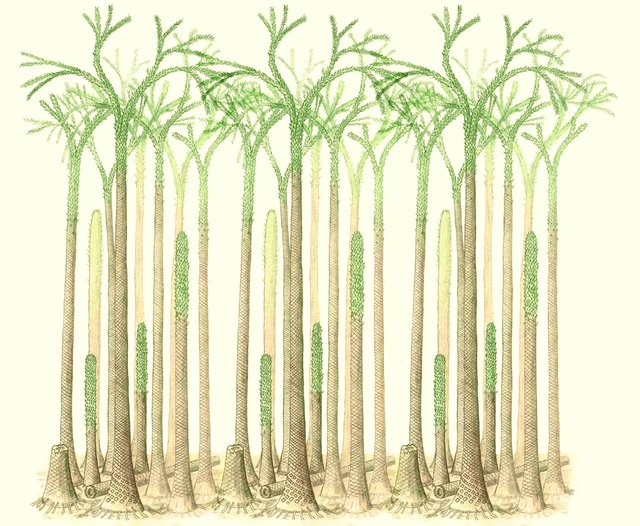Mother Earth Isn't Always So Nice: Death by Forests in the Devonian Mass Extinction
In that old mythologies, there were two parents to most of the gods. One was Mother Earth. The other was Father Sky. Mother Earth has become in recent decades to be a kind, sweet woman we are viciously abusing. There are reasons for that. For one we are, in fact, polluting the environment in a big way and it causes problems. Another reason though is a lot of the West no longer needs to fear the vicious side of Mother Nature, Mother Earth. Except when it comes to her occasional storm or earthquake, we have largely learned how to insulate our lives from Mom's mean side. And Disney's portrayal of Mother Nature as sweet and kind is another, to be sure. However, Mother Nature isn't the Disney version. If anything, she often eats her children. Sometimes she murders them wholesale. Those times are called mass extinctions and they happen quite often.
Mass extinctions are when vast swathes of life are wiped out. Not merely a single species or a type of life, but vast swathes of life: plants, animals, fungus, even probably microbial life, but definitely planktonic. A mass extinction is not confined to a single area, or continent either: a mass extinction is global. There have been numerous mass extinctions, probably well over one hundred, but six of them were so profound that science has acknowledged their place among mass extinctions as exceptionally bad. Those are the Holocene, Cretaceous/Paleogene, Triassic/Jurassic, End Permian, Devonian and Ordovician. There may be two more that are just as profound, the End Ediacaran and the Francevillian, but far more science must be done before they are acknowledged as being as profound as the so-called Big Six.
The last post discussed the end of the seas without fish (or very few at least). This post, today, will discuss the end of the Age of Fish. This post will cover the Devonian Mass Extinction.

Devonian paleogeography. img src: Geology Page
The Devonian Period stretched from approximately 419 million years ago until it ended 358 million years ago lasting approximately 61 million years. It started at the end of the Silurian and ended at the start of the Carboniferous. The Devonian is called the Age of Fish because the modern types of fish, the ray fished and lobe finned fish appeared and became quite important and ultimately dominant in the oceans. Sharks radiated and became far more numerous in the seas than they had been during the Silurian. On land, vascular plants, even the first seed bearing plants and forests evolved during this time frame. Even the first tetrapods - animals similar to what we would later call amphibians - invaded the land.
For the most part, the Devonian was a rather warm period. Temperatures were higher than today. The Devonian even started with higher levels of carbon dioxide in the atmosphere, but that would change. By the end of the Devonian an ice age, or more properly, a glaciation began. This was actually in large part because the forests of the world lacked sufficient animals capable of digesting the majority of their material. Vascular plants used a lot of lignin has part of their structure. This would be and largely still is indigestible by fungi. The later Carboniferous Period would be named for all the coal deposited during that time frame because the animals couldn't eat it and the fungi couldn't decompose it. The problem actually began in the Devonian but grew worse in the Carboniferous.
Animals wouldn't be able to eat a lot of the woody parts of a tree until later. Detritivores, animals that ate the partially decomposed bits of plants, were the predominant plant eaters until well into the Carboniferous. True herbivores began to emerge in the Carboniferous and finally becoming very common in the Permian. The first herbivores were, unsurprisingly, arthropods. Vertebrates appear not to have been able to eat plants until the end of the Carboniferous. This long build up with animals and fungi able to digest plants helped create the mass extinction in the Devonian.

Drawing of a Devonian fossil forest in Svalbard, Norway. Image credit: Christopher M. Berry / John E.A. Marshall / Sci.News.
The problem the new forests or more specifically the new land plants in general caused was two fold. The first part was all the new organic matter flowed into the oceans. This, like in the Ordovician, produced deep waters that were anoxic, or lacking oxygen. The carbon from the dead plants swept up the oxygen and the microbes that preferred those waters produced nasty chemicals on top of that. Hydrogen sulfide is one of them. That meant as the forests produced more, the more the oceans became toxic. Think of the oceans like the pond that the algae take over, becoming a place where fish cannot live and smells awful. Now imagine a whole ocean like that. Or at least the deep parts.
Most animals cannot live down in water where they cannot breathe, oxygen being required for all but a very small number of animals. The surface waters would remain oxygenated and in a few places the deeper waters would as well, but only to certain depths and in certain places. Those places were refuges or refugia in the scientific parlance.
Then there was a second problem caused by the now successful land plants: they drew down the carbon dioxide in the air. This cooled the planet. This, in turn, caused the glaciers to sprout and spread. Glaciers eat up ocean water and lock it away. This causes the ocean levels to drop. That meant there was less shallow water environments with plenty of oxygen for all the sea creatures of the time to live in. Massively reduced ranges lead to extinctions and this was a radical reduction in range for the sea creatures. And the extinctions followed.
Of the animals that disappeared those that lived in the bottom of the ocean, in the benthic zones, or lived crawling on the bottom of even shallow waters were hit the worst. Only one order of trilobites, the famous Paleozoic fossil arthropods, survived the extinction. However, many of the largest species were wiped out as well. The armored fish, called the Placoderms, were completely wiped out. All reef building organisms would be wiped out. Reef builders like we know them would not recover until well into the Mesozoic, tens of millions of years later. Ammonites were heavily impacted as well. Cystoids were wiped out. In total, the Devonian Mass Extinction was the third worst of the so-called Big Six Mass Extinctions. 50% of all genera were wiped out.
All of the above ought to sound very familiar. It seems to be rather similar in execution to the Ordovician Mass Extinction. The kill mechanism does appear to be similar: toxic seas in a hot house world followed by a switch over to a cold, glacial climate with still rather toxic oceans. While the kill mechanisms look pretty much the same, the root causes are probably different. There were not enough land plants in the Ordovician to draw down the oxygen. Rather, it is suspect that orogeny, the process of producing mountains, was the root cause. Specifically, it appears the creation of the Appalachian mountains is the suspected cause. However, a lot more science needs to be done to confirm that. Plants caused the Devonian Mass Extinction though.
The Devonian Mass Extinction has been described as "one d*mned thing after another" by Dr Hallam in the book Catastrophes and Lesser Calamities. There were two distinct pulses to the extinction. The first was the Kellwasser Event, which seems to have only affected the oceans: terrestrial ecosystems seem to have survived the first hard pulse just fine. Then came the Hagenberg Event at the end of the Devonian that affected but marine and terrestrial life. The time between was no picnic either. For fifteen million years, more animals and plants were dying out than evolving. Why this extinction was different and far more prolonged than the Ordivician despite similar kill mechanisms is still under investigation. However, it does make the Devonian Mass Extinction frightful and interesting on its own.
The extinction was so bad that it may have wiped out enough of the tetrapods, the four legged animals, to have produced Romer's Gap. There has been, until recently a complete lack of fossil tetrapods for almost 15 million years in the late Devonian until well into the Carboniferous. This culd mean the extinction was so bad, tetrapods were restricted to very few locations for a long time. Some had suggested all the older tetrapods were wiped out and new ones evolved in their place. However, the work of Dr Jennifer Clack , Dr Jason Anderson et al has shown there is at least one location where the tetrapods were thriving during the 'gap': Scotland. It may Scotland was a refuge that all tetrapods spread from after the extinction. It is also possible it is the only place where the fossils scientists have yet found. Others may be lying as yet to be found. Time will tell which it is.
The Devonian Mass Extinction, at least for now, was the third worst of the Big Six. However, it had a massive impact on life that followed. The oceanic ecosystems were completely changed, in some ways in wildly profound ways. From a certain point of view, the problem was the Gaian interconnectedness broke down. Trees developed a new way of growing in their race to be taller and produced chemicals, namely lignin, that were indigestible for life. In turn, the oceans became polluted and spewed toxic chemicals and the glaciers pulled in the waters as the carbon dioxide was depleted from the atmosphere. The carbon cycle was destroyed and life paid the price.
After the extinction, life would recover, over time and thrive once more. It would do so for fifty-five million years until the Caroniferous Rainforest Collapse. However, that would be a 'minor' mass extinction. Afterwords, life would continue until the Permain Extinctions, culminating the biggest mass extinction currently recognized, the Permian Extinction. The extinction that nearly ended all life.
However, in the Devonian mass extinction, Mother Nature, Mother Earth, slaughtered her children viciously. And she needed no help from Humanity to do this. She was no kind and loving figure during the Devonian.
If she ever was.
Devonian
https://en.wikipedia.org/wiki/Devonian
Carboniferous
https://en.wikipedia.org/wiki/Carboniferous
Detritivore
https://en.wikipedia.org/wiki/Detritivore
Tetrapods
https://en.wikipedia.org/wiki/Tetrapod
Paleontologists Unearth Tropical Fossil Forests in Norway
http://www.sci-news.com/paleontology/tropical-fossil-forests-svalbard-norway-03449.html
Evidence of mass extinction associated with climate change 375 million years ago discovered in Central Asia
https://www.sciencedaily.com/releases/2013/12/131213092841.htm
Late Devonian glacial deposits from the eastern United States signal an end of the mid-Paleozoic warm period
https://www.sciencedirect.com/science/article/pii/S0031018208002976
Ice and Its Consequences: Glaciation in the Late Ordovician, Late Devonian, Pennsylvanian‐Permian, and Cenozoic Compared
https://www.jstor.org/stable/10.1086/424580
Proetida (trilobites)
https://en.wikipedia.org/wiki/Proetida
Placodermi
https://en.wikipedia.org/wiki/Placodermi
Ammonoidea
https://en.wikipedia.org/wiki/Ammonoidea
Cystoidea
https://en.wikipedia.org/wiki/Cystoidea
Late Devonian Extinction
https://en.wikipedia.org/wiki/Late_Devonian_extinction
Devonian Times
http://www.devoniantimes.org/opportunity/massExtinction.html
Dr A. Hallam
Catastrophes and Lesser Calamities
https://www.amazon.com/gp/product/B003FBTXL8/ref=dbs_a_def_rwt_hsch_vapi_tkin_p1_i0
Romer's Gap
https://en.wikipedia.org/wiki/Romer%27s_gap
End-Devonian extinction and a bottleneck in the early evolution of modern jawed vertebrates
http://www.pnas.org/content/107/22/10131
An early tetrapod from 'Romer's Gap'.
https://www.ncbi.nlm.nih.gov/pubmed/12097908
A Diverse Tetrapod Fauna at the Base of 'Romer's Gap'
https://journals.plos.org/plosone/article?id=10.1371/journal.pone.0125446
A new tetrapod from Romer's Gap reveals an early adaptation for walking
https://www.cambridge.org/core/journals/earth-and-environmental-science-transactions-of-royal-society-of-edinburgh/article/new-tetrapod-from-romers-gap-reveals-an-early-adaptation-for-walking/80C43A9191A8A8D7866FD0739C20A480
Carboniferous Rainforest Collapse
https://en.wikipedia.org/wiki/Carboniferous_rainforest_collapse



Hi @anzha welcome to steemstem.
I noticed that you credited your images but did not give a link to the source. Linking to image sources is one of our standards. So we would love if you could add them :)
You are always welcome to join us and get more recognition for your posts. You can find more information about geopolis here or join our Discord server.